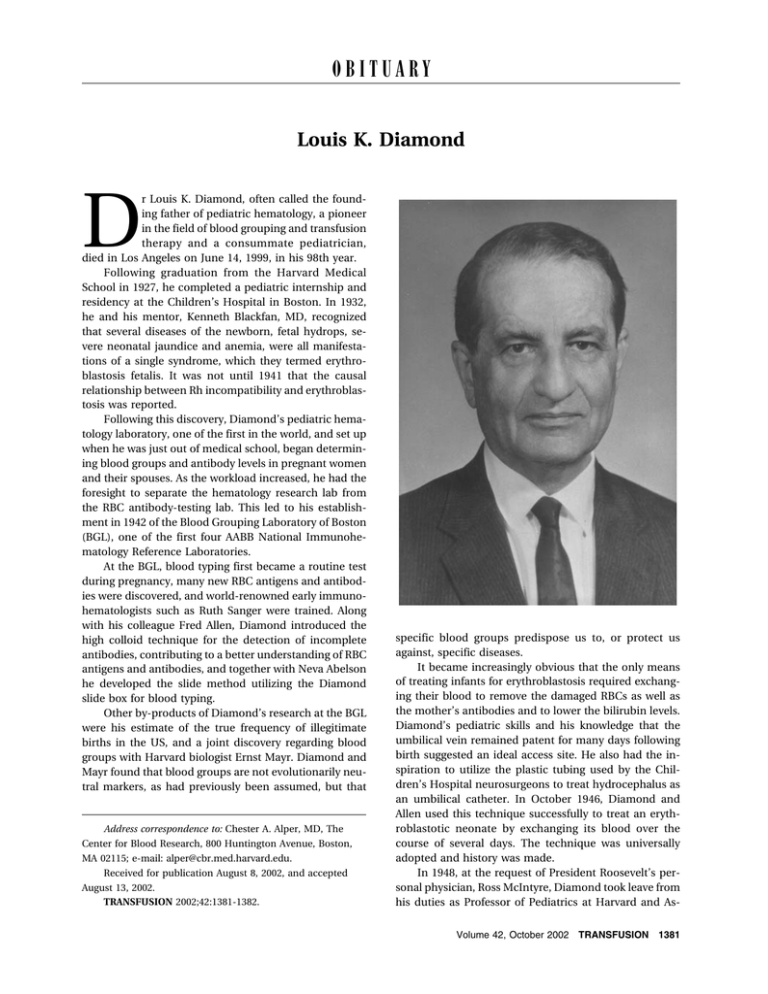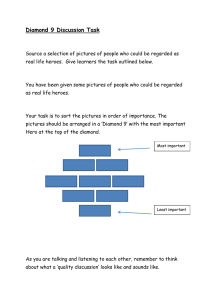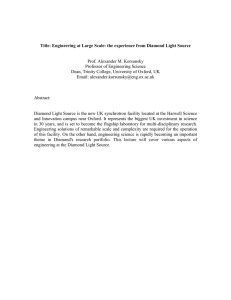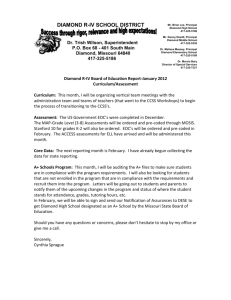Louis K. Diamond
advertisement

OBITUARY Louis K. Diamond D r Louis K. Diamond, often called the founding father of pediatric hematology, a pioneer in the field of blood grouping and transfusion therapy and a consummate pediatrician, died in Los Angeles on June 14, 1999, in his 98th year. Following graduation from the Harvard Medical School in 1927, he completed a pediatric internship and residency at the Children’s Hospital in Boston. In 1932, he and his mentor, Kenneth Blackfan, MD, recognized that several diseases of the newborn, fetal hydrops, severe neonatal jaundice and anemia, were all manifestations of a single syndrome, which they termed erythroblastosis fetalis. It was not until 1941 that the causal relationship between Rh incompatibility and erythroblastosis was reported. Following this discovery, Diamond’s pediatric hematology laboratory, one of the first in the world, and set up when he was just out of medical school, began determining blood groups and antibody levels in pregnant women and their spouses. As the workload increased, he had the foresight to separate the hematology research lab from the RBC antibody-testing lab. This led to his establishment in 1942 of the Blood Grouping Laboratory of Boston (BGL), one of the first four AABB National Immunohematology Reference Laboratories. At the BGL, blood typing first became a routine test during pregnancy, many new RBC antigens and antibodies were discovered, and world-renowned early immunohematologists such as Ruth Sanger were trained. Along with his colleague Fred Allen, Diamond introduced the high colloid technique for the detection of incomplete antibodies, contributing to a better understanding of RBC antigens and antibodies, and together with Neva Abelson he developed the slide method utilizing the Diamond slide box for blood typing. Other by-products of Diamond’s research at the BGL were his estimate of the true frequency of illegitimate births in the US, and a joint discovery regarding blood groups with Harvard biologist Ernst Mayr. Diamond and Mayr found that blood groups are not evolutionarily neutral markers, as had previously been assumed, but that Address correspondence to: Chester A. Alper, MD, The Center for Blood Research, 800 Huntington Avenue, Boston, MA 02115; e-mail: alper@cbr.med.harvard.edu. Received for publication August 8, 2002, and accepted August 13, 2002. TRANSFUSION 2002;42:1381-1382. specific blood groups predispose us to, or protect us against, specific diseases. It became increasingly obvious that the only means of treating infants for erythroblastosis required exchanging their blood to remove the damaged RBCs as well as the mother’s antibodies and to lower the bilirubin levels. Diamond’s pediatric skills and his knowledge that the umbilical vein remained patent for many days following birth suggested an ideal access site. He also had the inspiration to utilize the plastic tubing used by the Children’s Hospital neurosurgeons to treat hydrocephalus as an umbilical catheter. In October 1946, Diamond and Allen used this technique successfully to treat an erythroblastotic neonate by exchanging its blood over the course of several days. The technique was universally adopted and history was made. In 1948, at the request of President Roosevelt’s personal physician, Ross McIntyre, Diamond took leave from his duties as Professor of Pediatrics at Harvard and AsVolume 42, October 2002 TRANSFUSION 1381 ALPER ET AL. sociate Chief of Staff at Children’s Hospital to serve as medical director of the American Red Cross’s new National Blood Program. For 2 years he traveled the country, establishing technical procedures and quality standards still in practice today and negotiating cooperation among regional blood bank programs, helping to transform what had been an extraordinary war effort for the military into an ongoing peacetime service for all. Collaborating with Sidney Farber, MD, in 1948, Diamond launched the modern field of cancer chemotherapy by reporting the successful use of aminopterin to treat childhood acute lymphocytic leukemia. Among the many blood groups and diseases he discovered, three bear his name: Diamond-Blackfan syndrome, GardnerDiamond syndrome, and Schwachman-Diamond syndrome. His many awards include the Mead Johnson Award, the Apgar Award of the American Academy of Pediatrics, the Howland Award of the American Pediatric Society, and the Karl Landsteiner Memorial Award of the AABB for his expanding the knowledge of HDN. We specifically mention these three because they reflect his deep concern for clinical care and his loyalty to his patients. He 1382 TRANSFUSION Volume 42, October 2002 authored or co-authored nearly 200 papers and several texts, including the landmark Atlas of the Blood in Children and Erythroblastosis Fetalis. After reaching Harvard’s then-mandatory retirement age of 65, Diamond moved to California to serve as adjunct Professor of Pediatrics at the University of California at San Francisco from 1968 to 1987, and set up a pediatric hematology lab there. At the age of 85 he moved to the University of California at Los Angeles Medical School, remaining professionally active until his 90s. Diamond’s wife of almost 70 years, Flora Kaplan Diamond, died 6 months before him. He is survived by their son Jared Diamond, their daughter Susan Diamond, and four grandchildren. A centennial celebration of Diamond’s life will be held by The Center for Blood Research on October 26, 2002. For further information, please contact Jennifer Trapp at +1 617 278 3404. Chester A. Alper, MD e-mail: alper@cbr.med.harvard.edu Sherwin V. Kevy, MD Angelyn A. Konugres, PhD Boston, MA




